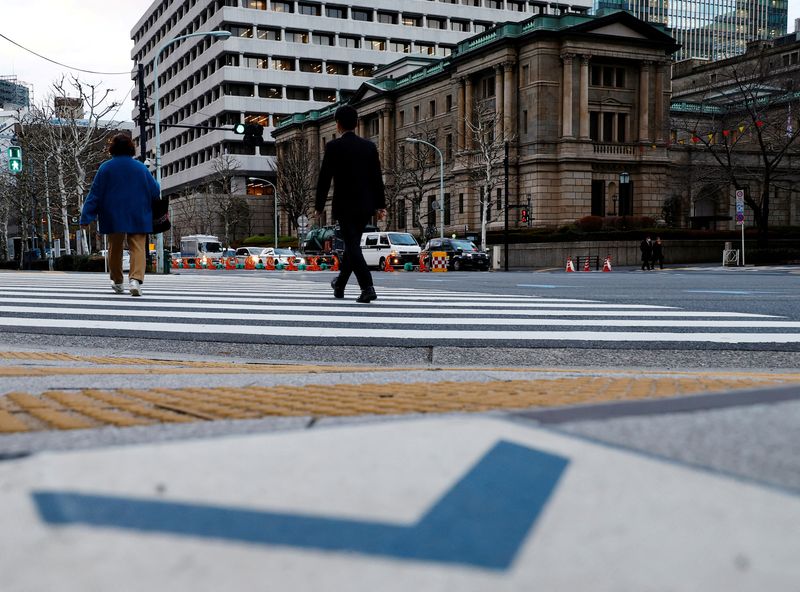By Leika Kihara
TOKYO (Reuters) - The Bank of Japan, kicking off its first meeting for 2024 this week, gave the clearest signal yet that an end to its years-long negative interest rate policy was approaching.
In a briefing after keeping ultra-loose policy on Tuesday, governor Kazuo Ueda said the chance of sustainably hitting the central bank's 2% inflation target was increasing.
Ueda pointed to encouraging signs in service-sector prices and wages that heightened the BOJ's conviction that conditions for phasing out ultra-loose policy settings are falling into place.
Many market players expect negative rates, in place since 2016, to end this year with the most likely timing seen as either at the meeting on March 18-19 or at the next one on April 25-26.
Below are key factors that could affect the timing of an end to negative rates and possible scenarios of an exit:
WHAT ARE THE KEY SIGNALS?
The BOJ added a new phrase in its quarterly outlook report that the likelihood of hitting 2% inflation "continued to rise gradually." While Ueda had made similar comments recently, putting it in the report was a big leap for the usually cautious BOJ as it shows the board is now unanimous in their view that conditions for winding down stimulus were falling into place.
The BOJ already projects trend inflation to stay near 2% in 2024 and 2025. But it wants to hold fire until it is convinced that wages and services inflation would rise enough to achieve the forecast.
That means any hints on the exit timing would come through subtle changes in the nuance or tone of BOJ policymakers' public comments on the prospects for durably achieving 2% inflation.
The BOJ tends to use pre-set seminars and speeches, rather than Ueda's parliament appearances, in delivering key signals on monetary policy.
WHEN COULD THE BOJ ACT?
Big firms' annual wage negotiations with unions conclude in mid-March, which set the course for smaller firms' talks and determine whether wage hikes become broad-based. Using its branch offices across the nation, the BOJ is also conducting hearings on regional firms to gauge the wage outlook.
That would give the BOJ enough evidence to justify ending negative rates in March. The BOJ typically times big policy changes at meetings when it issues a quarterly outlook report, which are in January, April, July and October. But Ueda did not close out the chance of breaking with that tradition, leaving the door open for a March action.
All the same, April is the more natural option, as the BOJ would produce for the first time growth and price projections for 2026. By forecasting inflation to hit 2% through 2026, it can more easily justify ending negative rates. A big policy shift in March could also unnerve many Japanese firms that close their books at the end of that month.
WHAT ARE RISKS THAT COULD DELAY AN EXIT?
Ueda gave no clear hints on whether the BOJ would indeed act in March or April, suggesting policymakers prefer to have some headroom to delay the move if economic uncertainties remain high.
While the chance of a soft landing for the U.S. economy is rising, the BOJ continues to warn that uncertainty regarding overseas growth remains high. A bigger-than-expected slump in U.S. and Chinese growth could hurt Japan's export-reliant economy, and prod the BOJ to delay an exit.
Recent weak signs in consumption also highlight the risk that households may start to curb spending if wages do not increase enough to make up for rising living costs.
WHAT HAPPENS WHEN AND AFTER NEGATIVE INTEREST RATES END?
Since taking the helm last year, Ueda has been gradually unwinding his predecessor's massive stimulus comprised of a short-term rate target of -0.1%, a 0% cap on the 10-year bond set under yield curve control (YCC), and massive asset purchases.
Having watered down YCC last year, the BOJ now has its eyes set on pulling short-term rates out of negative territory.
Ueda said the BOJ will keep monetary policy ultra-loose even after ending negative rates. That means the BOJ could keep short-term rates at zero for a protracted period, and only gradually hike them upon exiting negative rates.
It may also maintain YCC or keep buying enough bonds to avoid any abrupt spike in long-term interest rates. Such an incremental approach would allow the BOJ to better manage, and mitigate, the risks of market upheaval from what will be its first rate hike since 2007.
